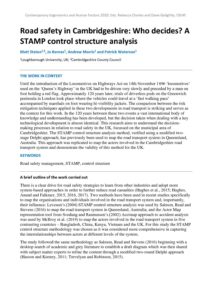| Document | Author Matt Staton, Jo Barnes, Andrew Morris and Patrick Waterson |
| Abstract Until the introduction of the Locomotives on Highways Act on 14th November 1896 ‘locomotives’ used on the ‘Queen’s Highway’ in the UK had to be driven very slowly and preceded by a man on foot holding a red flag. Approximately 120 years later, trials of driverless pods on the Greenwich peninsula in London took place where the vehicles could travel at a ‘fast walking pace’ accompanied by marshals on foot wearing hi-visibility jackets. The comparison between the risk mitigation techniques applied in these two developments in road transport is striking and serves as the context for this work. In the 120 years between these two events a vast international body of knowledge and understanding has been developed, but the decision taken when dealing with a key technological development is almost identical. This research aims to understand the decision-making processes in relation to road safety in the UK, focussed on the municipal area of Cambridgeshire. The STAMP control structure analysis method, verified using a modified two-stage Delphi approach, has previously been used to map the road transport system in Queensland, Australia. This approach was replicated to map the actors involved in the Cambridgeshire road transport system and demonstrate the validity of this method for the UK. |

